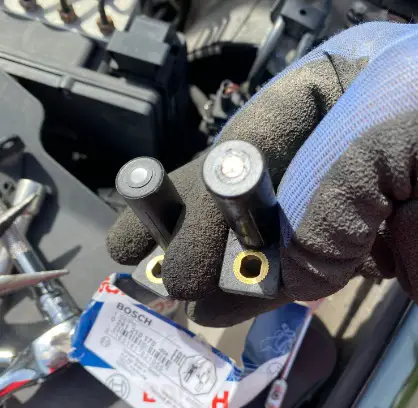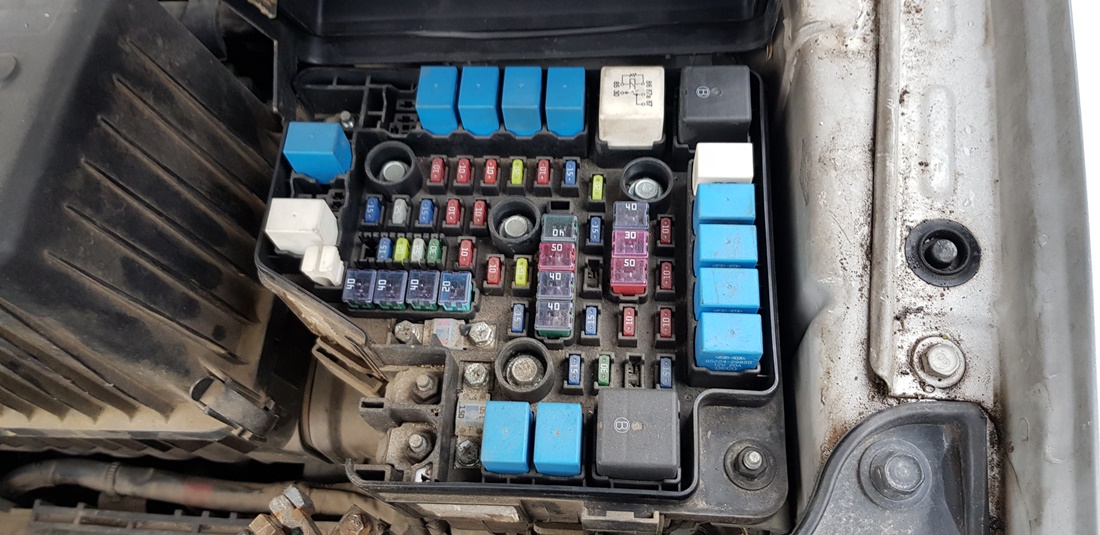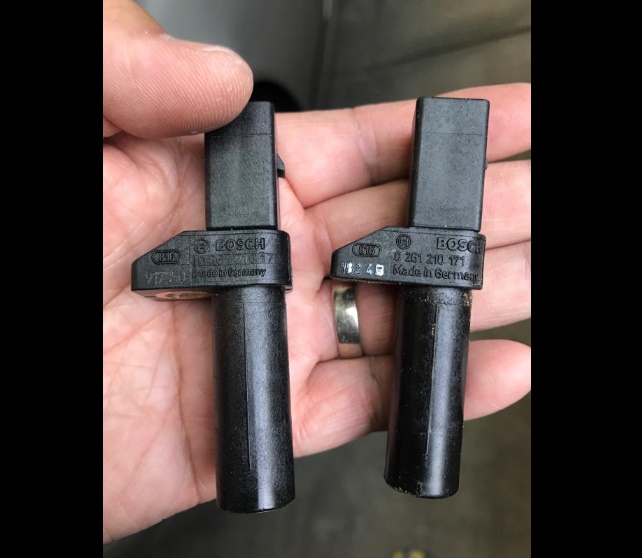How do you know if you need transmission fluid? When the fluid in your transmission gets too low, numerous problems can occur. This is because the fluid in the transmission is responsible for lubricating the transmission, powering the transmission, and cooling the transmission.
A lot of people ask if there are any indicators that say you need transmission fluid in your vehicle. In this article, I am going to talk about transmission fluid, what it does, why it is needed, and how can you tell if your vehicle is running low on transmission fluid.
- Key Takeaway
- What Does The Transmission Fluid Do?
- Signs That Your Car Needs Transmission Fluid
- How Long Can I Go Without Transmission Fluid?
- Can I Just Add Transmission Fluid?
- How Does a Car Act When It Needs Transmission Fluid?
- What Happens If You Drive With Low Transmission Fluid?
- FAQs
- Q: What are the signs that your transmission fluid is low?
- Q: How can you check the transmission fluid level?
- Q: What should you do if your transmission fluid is low?
- Q: What are the signs that your transmission needs a service?
- Q: How often should you change your transmission fluid?
- Q: What are the benefits of a transmission fluid flush?
- Q: What should you do if your transmission is grinding?
- Q: Should you contact a service center if you suspect a transmission problem?
- Q: What should you do if you suspect a transmission fluid leak?
- In Conclusion
Key Takeaway
- Transmission fluid lubricates the moving parts within your vehicle’s transmission, cools the transmission by dispersing heat, and aids in the process of gear shifting.
- Signs that your car needs transmission fluid include difficulty shifting gears, a whining noise, gears slipping, inability to go into reverse gear, overheating, a burning smell or smoke, and spotting a puddle of red fluid under your car.
What Does The Transmission Fluid Do?

The transmission fluid circulates throughout the transmission and provides the necessary lubrication of the moving parts, prevents the transmission from overheating by absorbing the heat from the moving parts, maintains fluid pressure, and prevents oxidation and rust.
The transmission fluid operates in what mechanics call work cycles. In one work cycle, the transmission fluid travels from the fluid pan, through the filter, and into the fluid pump. The fluid pump then forces the transmission fluid in the valve body of the mechatronic at high pressure.
The mechatronic regulates the pressure and distributes the fluid to the torque converter and the various sections of the gearbox. After that, the fluid goes through the cooling system and re-enters the transmission for the next work cycle.
Without enough transmission fluid, the transmission will overheat and the vehicle will not move because there’s not enough fluid to propel it. In most cases, the transmission will start to fail internally such as bearing and gearset failures.
Signs That Your Car Needs Transmission Fluid
- Stiff/hard shifting
- Delayed shifting/engagement
- Transmission slipping
- Transmission is overheating
- Burning smell from under the hood
- A whining sound from the transmission
If your vehicle is running low on transmission fluid, you will notice some unusual symptoms. The intensity of the symptoms that a vehicle with low transmission fluid shows will depend on how much exactly fluid is your vehicle missing.
Here are the most common signs that you need to add transmission fluid to your vehicle.
1. Stiff/hard shifting

Stiff/hard shifting usually occurs when the transmission fluid is low. There are a lot of moving parts coupled with rubber seals around the shafts inside the transmission and if there is not enough transmission fluid to lubricate them, these seals will wear, shrink, or brittle over time causing a hard shifting.
Hard shifting is not something that you want to experience. When the automatic transmission shifts from one gear to another it feels like a jolt. Like someone is pushing you forward or back.
The most common symptom for hard shifting is low transmission fluid. That is exactly where you should start. Check the transmission fluid dipstick and add more fluid if needed.
However, if you find yourself adding transmission fluid regularly in order to get back to a smooth shifting, you should probably take your vehicle to a mechanic and see why your transmission is losing fluid.
2. Delayed shifting/engagement

Delayed shifting is a delayed engagement of the gears. This issue occurs when the automatic transmission is low on fluid. What happens is, there is not enough fluid to lubricate the gears. So, when you put the car in drive or reverse, the shift engagement is delayed because there is not enough fluid to move the parts.
A delayed shifting is when you put your car in drive or reverse and the car doesn’t move immediately even if you push the gas pedal. It could take a second, two, or even five seconds before the gear engages. The engagement time will depend on how much fluid you have left in your automatic transmission.
To solve this issue, you will have to add more transmission fluid. However, if adding more transmission fluid doesn’t solve the problem, it is possible that some of the other transmission components like seals or bands have been damaged.
3. Transmission is slipping

When the automatic transmission has low transmission fluid, the fluid pump will run dry causing the torque converter that creates the pressure to run dry as well. At this point, there is no hydraulic pressure to the solenoid and the transmission will start to slip.
Being low on transmission fluid not only causes the automatic transmission to start slipping, but it can cause the friction plate and clutch bands to prematurely wear.
Simply said, when you put your car in drive and the actual gear changes into drive but the car doesn’t move and just revs, your transmission is slipping.
The damage that insufficient transmission fluid can cause to the automatic transmission can be seen by dropping the fluid pan and checking the transmission fluid. Look for any grit or fibrous materials.
This means that the friction plates have been damaged or completely destroyed says Phillips Toyota.
4. Transmission is overheating
The transmission fluid is responsible for absorbing the heat from the transmission components, therefore keeping the transmission temperature around 175 degrees Fahrenheit. If your vehicle is low on transmission fluid, the temperature of the automatic transmission will rise above 200 degrees Fahrenheit, causing it to overheat.
The transmission fluid is responsible for many things. One of those things is to cool down the automatic transmission. So, as the transmission fluid starts its work cycle from the fluid pan, it goes to the fluid filter and pump and gets pumped to all of the transmission components.
By doing so, the fluid absorbs the heat from the moving components of the automatic transmission and then goes to the fluid pan where it gets cooled down before starting another work cycle.
Having insufficient levels of transmission fluid will result in overheated transmission. There won’t be enough fluid to absorb the heat from the components and the temperature within the transmission will rise and components like seals will get damaged.
You could try to refill the transmission fluid and see if that will fix your problem. However, if you drive too far without enough transmission fluid, there is a great chance that some of the internal components of the transmission will get damaged, and simply topping up the fluid won’t help.
5. Burning smell from under the hood
When your automatic transmission starts to lose fluid, you will sense a burning smell from under the hood. The smell of transmission fluid is very similar to burnt toast. It is a very distinct smell and is very different from burnt oil or burnt coolant.
Transmission fluid usually starts to leak when some of the seals become worn. It is very important to notice this issue early on because driving your vehicle with a low transmission fluid can cause serious damage to the internal components of the transmission.
So, if you notice a burnt toast smell from under the hood, make sure to check your transmission fluids. If the fluid is leaking badly, you will notice a puddle underneath the vehicle. But in most cases, the transmission fluid leakage is too small to form a puddle, but you can smell it from under the hood.
6. Whining noise coming from the transmission
The clutch packs and other components of the automatic transmission wear over time and they start clogging up the screen where the transmission fluid pump sucks in the fluid and forms air bubbles. At this point, there is not enough transmission fluid circulating inside the transmission and as a result, you can hear a whining noise coming from the transmission.
The whining noise that transmission produces can be very similar to the noise that a bad power steering pump makes. So, the best way to check and confirm that the noise is coming from your transmission is to sit in the car while it runs and turn the steering wheel left and right. If the noise amplifies as you turn the steering wheel, then it is the pump.
However, if the noise continues with the same intensity, your transmission is making a whining noise because of the low lubrication. At this point, you can add more transmission fluid and see if that will make the sound go away.
But, if the whining noise is still there, you should take your vehicle to the mechanic. Overall, transmissions are very expensive and you need to make sure that you always have enough transmission fluid in your transmission.
How Long Can I Go Without Transmission Fluid?
Depending on your vehicle model and make, you will probably be able to drive around 25 to 30 miles without transmission fluid before your transmission completely fails. However, if you are only missing 30% to 40% transmission fluid, you will be able to drive further, but with a high chance of damaging the transmission.
Many car owners who don’t have the habit of checking the transmission fluid are driving around with insufficient fluid without even knowing it. If your vehicle is losing transmission fluid due to leaks or for some other reason, you won’t be able to feel or see the damage immediately. This is of course unless the leak is so bad and the whole transmission fluid drains in a matter of minutes.
If you are missing around 30%-40% transmission fluid, you will be able to drive without noticing. However, once the transmission fluid gets dangerously low, you will start to experience hard shifting, gear slipping, or even a whining noise coming from the transmission.
However, if your vehicle has no transmission fluid inside the transmission, you will be able to drive it around 25 to 30 miles. During this drive, you will notice that the car is shaking, it is almost impossible to shift, and the car will get hot on the bottom where the transmission lays because there is no fluid to cool it down.
Can I Just Add Transmission Fluid?
Yes, if your vehicle is low on transmission fluid you can add more transmission fluid into the tube where the dipstick is installed. However, depending on what the issue is and why your transmission leaked the fluid is something that you should investigate.
The transmission is a closed system. This means that the transmission fluid should circulate inside the transmission and cool down the components. Once the transmission fluid makes a full cycle, it goes down to the fluid pan where it gets cooled down and ready for the next cycle.
So, if your vehicle is low on transmission fluid, there has to be a leak somewhere. This is something that you should investigate. However, you can add more transmission fluid in the meantime so your vehicle doesn’t operate without this vital component.
When adding transmission fluid, you have to be careful not to add too much or too little. There are markings on the transmission fluid dipstick that will tell you exactly how much is enough. In any case, make sure that your vehicle has enough transmission fluid at all times.
How Does a Car Act When It Needs Transmission Fluid?
When a car needs transmission fluid, it may exhibit signs such as difficulty or abruptness in shifting gears, gear slippage, unusual noises during gear shifts, delayed response in movement, and potential transmission fluid leakage.
The car might also experience gear slippage, where the vehicle switches gears without any input from the driver or moves up and down gears sporadically.
Unusual noises like grinding or clunking when shifting gears can also indicate low transmission fluid.
Additionally, the car may have a delayed response in movement, known as transmission lag, especially noticeable when trying to move from a complete stop.
Lastly, the car may also leak transmission fluid, which is typically a bright red, clear liquid.
What Happens If You Drive With Low Transmission Fluid?
Driving with low transmission fluid can lead to increased friction and wear of transmission parts, potential overheating, difficulty in shifting gears, or even vehicle stalling, all of which can result in costly repairs or dangerous driving conditions.
FAQs
Q: What are the signs that your transmission fluid is low?
A: The signs of low transmission fluid include difficulty shifting gears, the transmission overheating, and a noticeable reduction in the performance of your vehicle.
Q: How can you check the transmission fluid level?
A: To check the transmission fluid level, locate the transmission dipstick under the hood of your car. Remove the dipstick, wipe it with a clean cloth, and then reinsert it. Pull it out again and check the fluid level. It should be within the range indicated on the dipstick.
Q: What should you do if your transmission fluid is low?
A: If your transmission fluid is low, you should add more fluid to bring it back to the appropriate level. It is recommended to use the type of fluid specified in your vehicle’s owner’s manual.
Q: What are the signs that your transmission needs a service?
A: The signs that your transmission needs a service include shifting delays, slipping out of gear, and unusual noises coming from the transmission. You may also notice a burning smell or a leak underneath your vehicle.
Q: How often should you change your transmission fluid?
A: The frequency of transmission fluid changes can vary depending on the make and model of your vehicle. As a general guideline, it is recommended to change the transmission fluid every 30,000 to 60,000 miles or as specified in your vehicle’s owner’s manual.
Q: What are the benefits of a transmission fluid flush?
A: A transmission fluid flush helps to remove old, dirty fluid and replace it with fresh fluid. This can improve the performance and longevity of your transmission, as well as prevent costly transmission repairs in the future.
Q: What should you do if your transmission is grinding?
A: If your transmission is grinding, it is a sign that there may be a problem with the transmission gears. It is important to have your vehicle inspected by a qualified auto repair professional to diagnose and repair the issue.
Q: Should you contact a service center if you suspect a transmission problem?
A: Yes, if you suspect a transmission problem, it is recommended to contact a reputable service center that specializes in transmission repair. They have the expertise and equipment to properly diagnose and fix any issues with your transmission.
Q: What should you do if you suspect a transmission fluid leak?
A: If you suspect a transmission fluid leak, it is important to have your vehicle inspected as soon as possible. Continuing to drive with a transmission fluid leak can cause damage to your transmission and result in costly repairs. Contact a service center to schedule an appointment.
In Conclusion
It’s important to know when it is time to get your transmission fluid replaced.
If you notice any changes in the way your vehicle shifts or you are having difficulty getting it into gear, these could be signs that you need a transmission fluid change.




